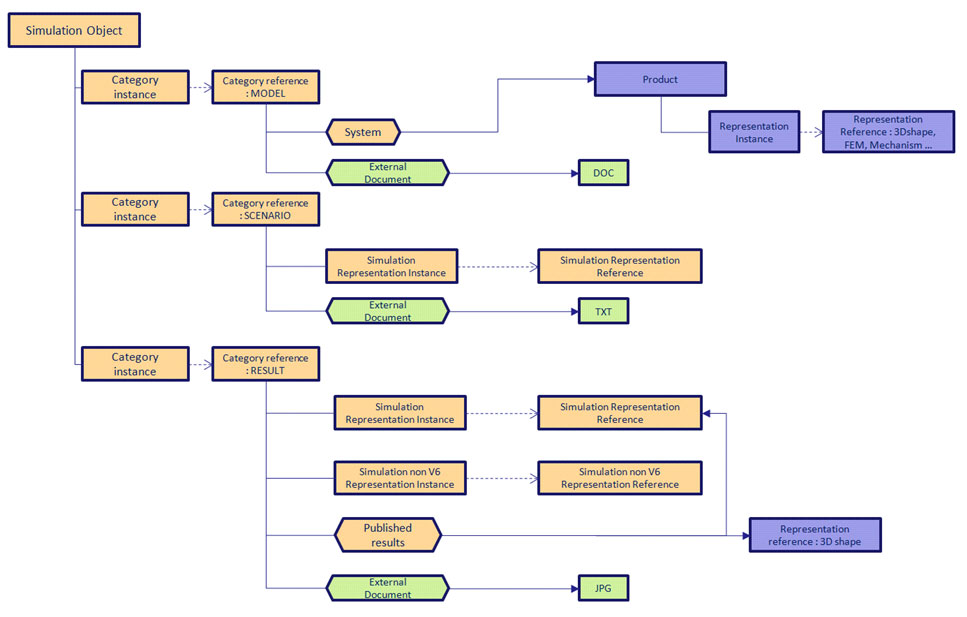
Simulation Modeler Description & Customization |
| Technical Article |
|
This article presents the Simulation modeler, and explains how to customize it. |
This section first presents the objects representing the Simulation modeler. Then it describes how this object model view has been translated towards PLM objects based on PLM Core Modeler objects. You will see the description of each PLM package defining these PLM objects.
The simulation modeler is composed of two main parts: objects used to define a simulation, its categories and its contents, and a connection to the simulated model.
This is summarized in the following UML schema:
 |
Simulation modeler is described through four modeler PLM packages :
All simulations are implemented using the SIMObjSimulationObjectGeneric class of SIMObjSimulationGeneric PLM Package. It is the V_discipline attribute of this PLM class that is used to sub-type the simulation. Currently the existing discipline values are : .
Non V5 representation is implemented using the SIMObjSimulationRepReferenceGeneric and SIMObjSimulationRepInstanceGeneric classes of the PLM package SIMObjSimulationGeneric. they can contain for instance results of the computations of the solver.
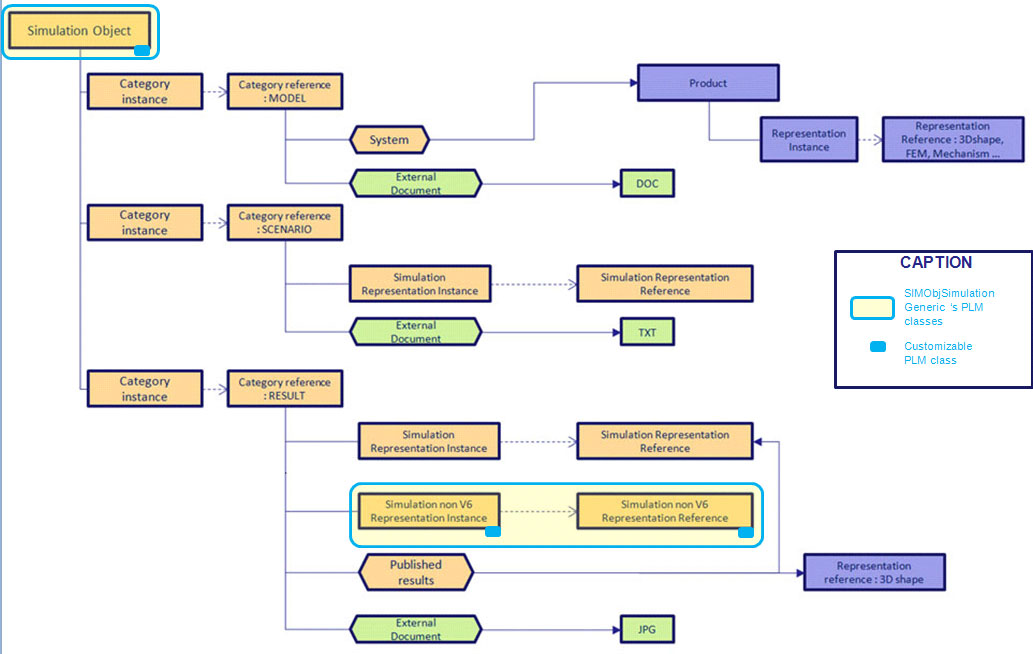 |
| PLM Core Class | Specialized as |
|---|---|
| PLMCoreReference | SIMObjSimulationObjectGeneric |
| PLMCoreRepReference | SIMObjSimulationRepReferenceGeneric |
| PLMCoreRepInstance | SIMObjSimulationRepInstanceGeneric |
Refer to the modeler PLM package documentation [1] for a complete view of its contents included 3DXML support.
Simulation categories are implemented using the SIMObjSimulationCategoryReference and SIMObjSimulationCategoryInstance classes of the PLM Package SIMObjSimulationCategoryAndProdCnx. It is the V_discipline attribute of this PLM class that is used to type the category. Currently the existing values for the references are :
|
|
|
System connection is implemented using the SIMObjSimulationSystem class of the PLM Package SIMObjSimulationCategoryAndProdCnx. this class can point to either a physical, logical or PPR product.
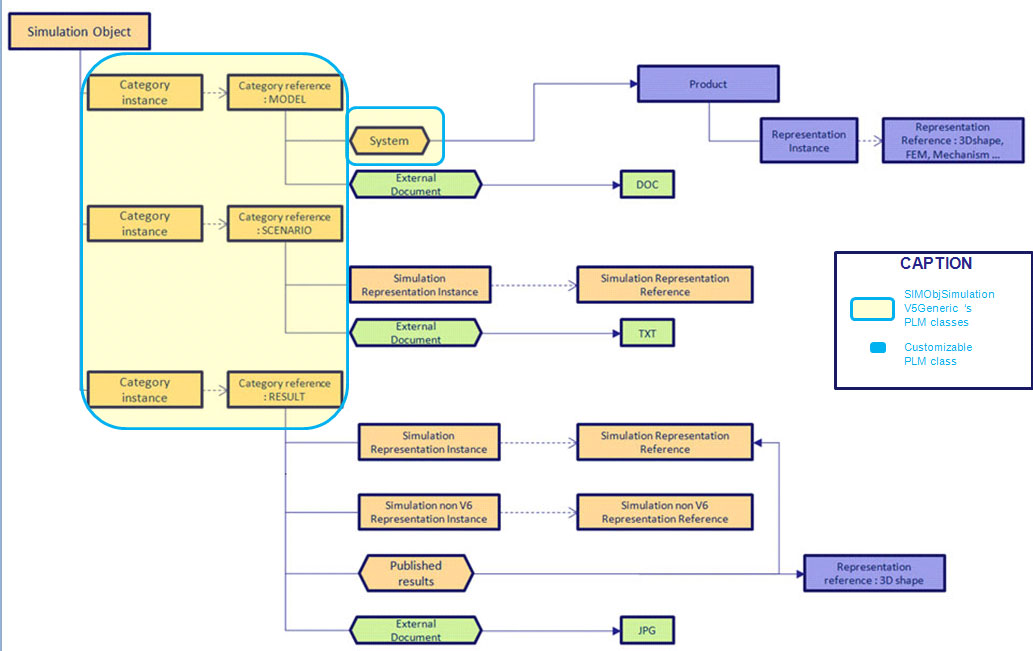 |
| PLM Core Class | Specialized as |
|---|---|
| PLMCoreReference | SIMObjSimulationCategoryReference |
| PLMCoreInstance | SIMObjSimulationCategoryInstance |
| PLMConnection | SIMObjSimulationSystem |
Refer to the modeler PLM package documentation [1] for a complete view of its contents included 3DXML support.
V5 rep representation is implemented using the SIMObjSimulationV5RepReferenceGeneric and SIMObjSimulationV5RepInstanceGeneric classes of the PLMPackage SIMObjSimulationV5Generic. It contains all the features needed for the simulation : excitations, probes, scenarios, results, sub-results ...
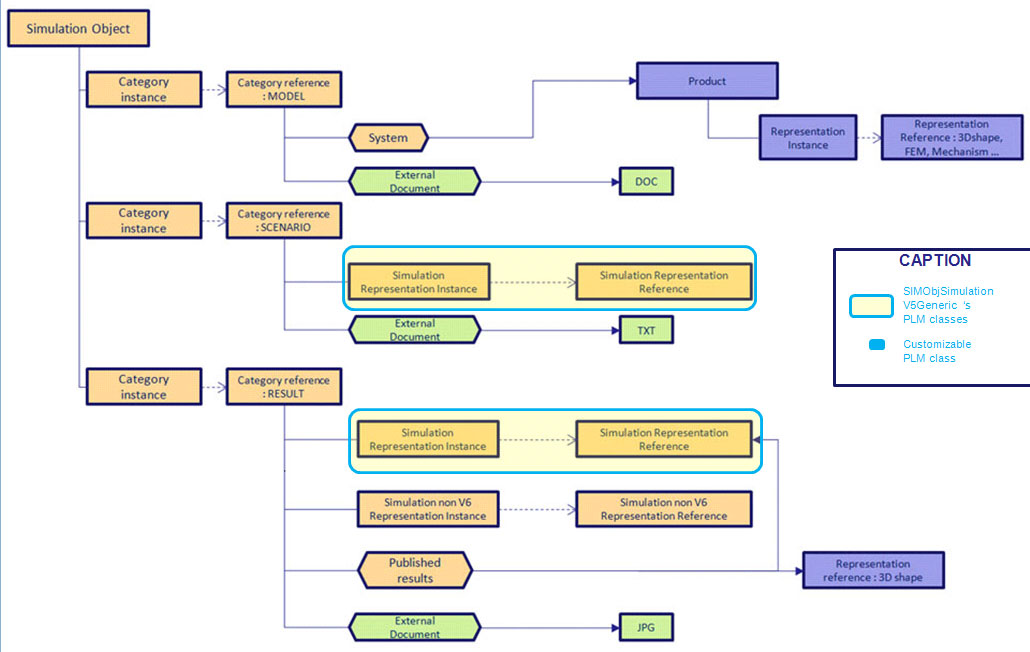 |
| PLM Core Class | Specialized as |
|---|---|
| PLMRepReference | SIMObjSimulationV5RepReferenceGeneric |
| PLMRepInstance | SIMObjSimulationV5RepInstanceGeneric |
Refer to the modeler PLM package documentation [1] for a complete view of its contents included 3DXML support.
V5 rep representation is implemented using the SIMObjectSimulationPublishedResultCnx class of the PLMPackage SIMObjSimulationPublishedResultCnx. It is used to connect fetaures results with non V5 or V5 representation.
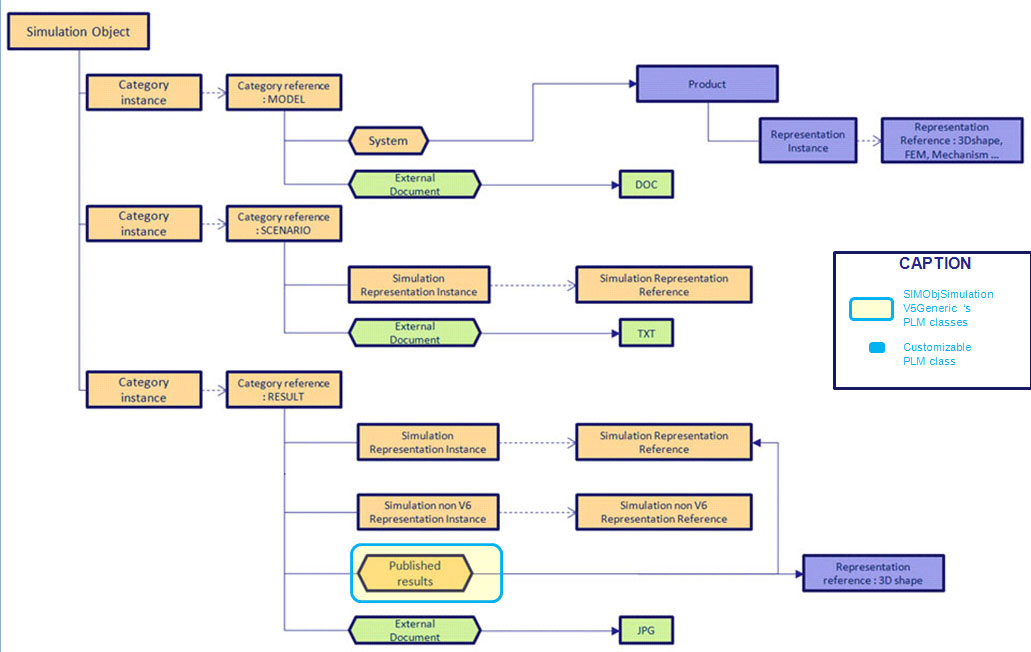 |
| PLM Core Class | Specialized as |
|---|---|
| PLMConnection | SIMObjectSimulationPublishedResultCnx |
Refer to the modeler PLM package documentation [1] for a complete view of its contents included 3DXML support.
This section lists and describes the PLM Opening ID implemented by the following PLM classes of the Simulation modeler.
Customization first deals with the modeler PLM package customization [2]. It consists in to create a new package containing new PLM classes for each "Customizable" PLM class of the modeler PLM package. Then, you should take into account the UI masks creation to create either a new security mask file, or to update the default one [3]. Finally, you can integrate your own business logic on each new PLM classes by implementing provided PLM opening ID [4].
This part consist in to create a new package when the modeler PLM package must be customized.
SIMObjSimulationGeneric must be fully customized.
| PLM Class Name | To Be Customized | Remarks |
|---|---|---|
| SIMObjSimulationObjectGeneric | Yes | |
| SIMObjSimulationRepReferenceGeneric | Yes | |
| SIMObjSimulationRepInstanceGeneric | Yes |
When a PLM attribute is defined (inside modeler PLM package) some features like its editability criteria, mandatory /optional option, can be overwriten by UI mask. You can say this PLM attribute is not writable in Query context, this PLM attribute is mandatory in Create context, this user PLM attribute is not never visible and so one. A set of UI masks form a security mask file. We say security mask because it is associated with these files security information. For a people, and a given context can be associated a security mask.
For each customized Modeler PLM package, at least one UI mask file must be created (for the default security mask ), since it must contain the new PLM Attributes. When you use the tool to create a customization, a default UI mask file is provided taken into account the added PLM attributes. You can modify the default file to introduce your change .
If you want create a new sec urity mask file, you should provide a UI mask for all the "AsIs" modeler PLM packages and for each customization of the "Customizable" modeler PLM package.
To create a UI mask you should respect the following rules :
You can yourself integrate your business logic for each customization of:
PLM Opening ID Remarks PLMImportExportAttributesValuation PLMIdentificationInitialization
SIMObjSimulationRepReferenceGeneric
PLM Opening ID Remarks ManageNavRep
PLMIdentificationInitialization
ManageNavRep
SIMObjSimulationV5RepReferenceGeneric
PLM Opening ID Remarks PLMIdentificationInitialization
SIMObjSimulationRepReference
PLM Opening ID Remarks PLMIdentificationInitialization
SIMObjSimulationCategoryReference
PLM Opening ID Remarks PLMIdentificationInitialization
ManageNavRep
SIMObjSimulationObject
PLM Opening ID Remarks PLMIdentificationInitialization
| [1] | PackageExternalName1 |
| [2] | Modeler PLM Package Concepts and Customization Principles |
| [3] | UI Mask Concepts and Customization Principles |
| [4] | Business Logic Concepts and Customization Principles |
<Each package name in the reference table is an external name, but the links refer to a file whose the name is build with the package's internal name >
| Version: 1 [Fev 2009] | Document created |